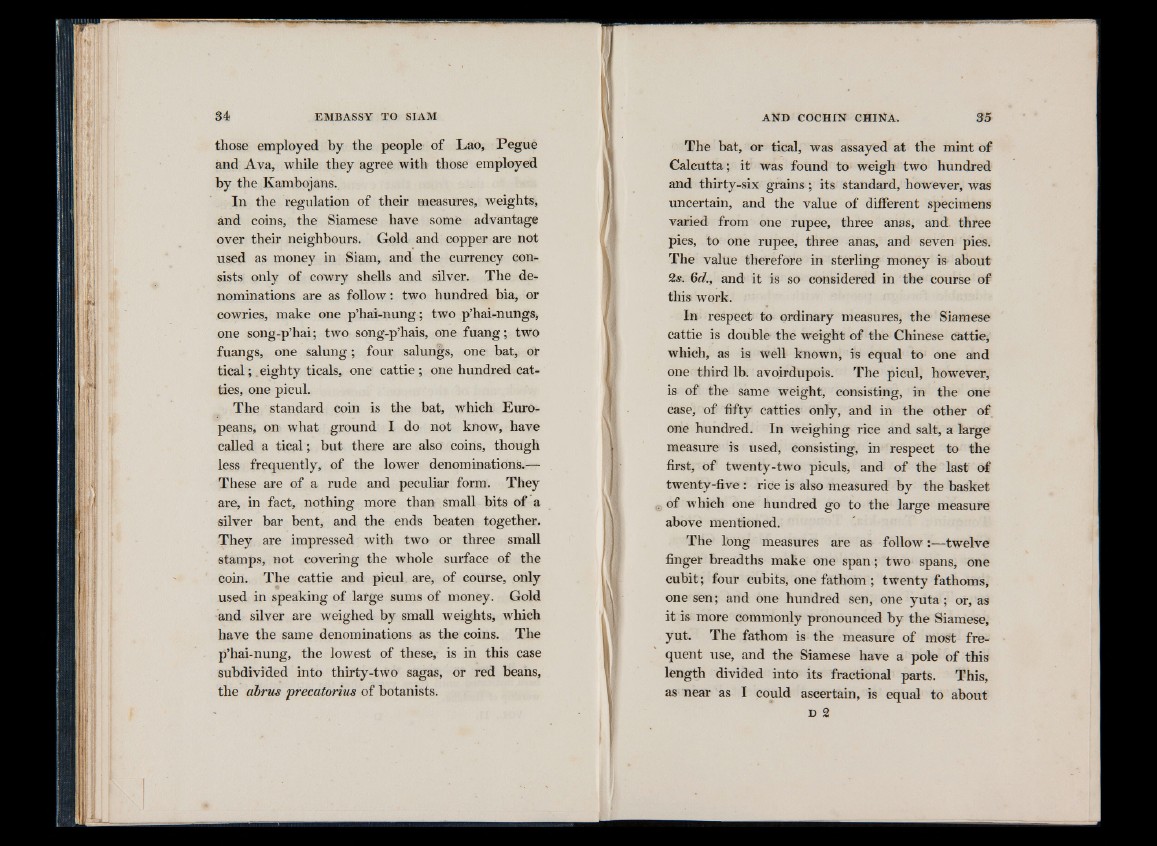
those employed by the people of Lao, Pegue
and Ava, while they agree with those employed
by the Kambojans.
In the regulation of their measures, weights,
and coins, the Siamese have some advantage
over their neighbours. Gold and copper are not
used as money in Siam, and the currency consists
only of cowry shells and silver. The denominations
are as follow: two hundred bia, or
cowries, make one p’hai-nung; two p’hai-nungs,
one song-p’hai; two song-p’hais, one fuang; two
fuangs, one salung; four salungs, one bat, or
tical; .eighty ticals, one cattie ; one hundred catties,
one picul.
The standard coin is the bat, which Europeans,
on what ground I do not know, have
called a tical; but there are also coins, though
less frequently, of the lower denominations.—
These are of a rude and peculiar form. They
are, in fact, nothing more than small bits of a
silver bar bent, and the ends beaten together.
They are impressed with two or three small
stamps, not covering the whole surface of the
coin. The cattie and picul are, of course, only
used in speaking of large sums of money. Gold
and silver are weighed by small weights, which
have the same denominations as the coins. The
p’hai-nung, the lowest of these, is in this case
subdivided into thirty-two sagas, or red beans,
the dbrus precatorius of botanists.
The bat, or tical, was assayed at the mint of
Calcutta; it was found to weigh two hundred
and thirty-six grains; its standard, however, was
uncertain, and the value of different specimens
varied from one rupee, three anas, and three
pies, to one rupee, three anas, and seven pies.
The value therefore in sterling money is about
2s. 6d., and it is so considered in the course of
this work.
In respect to ordinary measures, the Siamese
cattie is double the weight of the Chinese cattie,
which, as is well known, is equal to one and
one third lb. avoirdupois. The picul, however,
is of the same weight, consisting, in the one
case, of fifty catties only, and in the other of
one hundred. In weighing rice and salt, a large
measure is used, consisting, in respect to the
first, of twenty-two piculs, and of the last of
twenty-five: rice is also measured by the basket
of which one hundred go to the large measure
above mentioned.
The long measures are as follow:—twelve
finger breadths make one span; two spans, one
cubit; four cubits, one fathom ; twenty fathoms,
one sen; and one hundred sen, one y u ta ; or, as
it is more commonly pronounced by the Siamese,
yut. The fathom is the measure of most frequent
use, and the Siamese have a pole of this
length divided into its fractional parts. This,
as near as I could ascertain, is equal to about
D 2